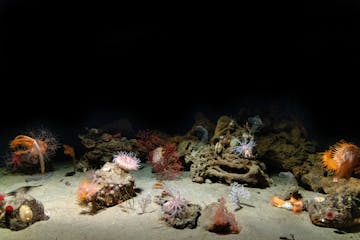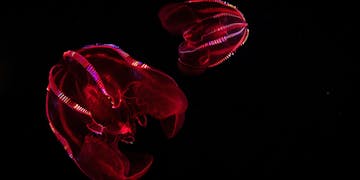The deep sea is the largest living space on Earth. This realm of inky darkness, frigid temperatures, and crushing pressure remains shrouded in mystery. Scientists have explored just a fraction of the deep sea. MBARI research has revealed the ocean’s depths are home to an astonishing diversity of life. We now recognize the deep sea is the foundation for a healthy, functioning ocean and stable climate.
For most people, the deep sea remains a distant and inaccessible place. A new exhibition at the Monterey Bay Aquarium, MBARI’s education and conservation partner, seeks to change that. Into the Deep: Exploring Our Undiscovered Ocean / En lo Profundo: Explorando Nuestro Océano Desconocido brings the deep sea to land.
Into the Deep invites Aquarium visitors to descend into the depths. Under development for more than five years, the 10,000-square-foot exhibition features 21 live exhibits representing dozens of novel species for the Aquarium. The exhibition puts visitors face to face with denizens of the deep, including bloody-belly comb jellies, bubblegum corals, Japanese spider crabs, giant isopods, and even some newly discovered animals so new to science that they have not yet been formally described. Interactive exhibits and immersive video experiences offer visitors a deeper dive into life in the largest living space on Earth.
The exhibition also highlights MBARI’s work to understand the deep sea, from our research documenting the diversity of deep-sea life to our technology innovation for monitoring ocean health. MBARI vessels and vehicles and the expertise of our marine operations team were instrumental in bringing rarely seen deep-sea animals to public display, many for the first time anywhere in the world.
Importantly, Into the Deep highlights our connection to the deep sea and provides ways visitors can safeguard its fragile future. Though it seems distant from human influence, the deep sea faces the same threats as the rest of the ocean—fishing pressure, habitat destruction, plastic pollution, and climate change—but is less resilient to those kinds of disturbances. The new exhibition takes the Aquarium’s mission of inspiring ocean conservation to new depths, just as new threats are emerging that may alter the deep sea before we have had a chance to study it.
“Now more than ever, we must grow the community of scientists and engineers to fully understand our amazing blue planet and preserve it for future generations. We hope Into the Deep will inspire a new generation of ocean explorers to join us in our vital work to understand a changing ocean.” —MBARI President and CEO Chris Scholin
MBARI has a long history of collaboration with the Monterey Bay Aquarium.
After he funded the creation of the Aquarium, David Packard recognized the need for a separate research institution focused on developing innovative technologies for exploring and understanding the ocean. He founded MBARI in 1987 to establish a new type of oceanographic institution—one where scientists and engineers worked side-by-side—because he believed the ocean was the most important frontier we have left.
Though we operate independently of one another, MBARI and the Aquarium collaborate on a continuous basis in support of our shared ocean research and conservation goals. MBARI is the Aquarium’s research and technology partner, and the Aquarium is MBARI’s education and conservation partner. Together, we work to educate the public about the ocean and share the knowledge and technology innovations gained from MBARI’s work with the global science and conservation community.
The Into the Deep exhibition is the ultimate expression of our close relationship and showcases each organization’s complementary expertise.

MBARI research vessels and marine operations crew supported the collection of animals from the depths of Monterey Bay using underwater robots called remotely operated vehicles, or ROVs. MBARI’s engineering team made custom modifications to our vehicles to make it easier for the Aquarium to observe deep-sea animals, study them in their natural habitat, collect them, and bring them back safely to shore.
MBARI’s extensive archive of video observations of deep-sea animals, annotated with environmental data like temperature, salinity, and oxygen levels, helped guide the Aquarium’s animal care team to identify the optimal living conditions for deep-sea animals. Behind the scenes, the Aquarium has constructed an elaborate life support system to replicate the deep-sea conditions these animals need to thrive. The water treatment system is the most complicated and sophisticated the Aquarium has ever designed. While all the animals on exhibit can survive at surface pressure, the life support systems replicate the varied conditions required by deep-sea life that thrives in frigid, less basic (more acidic), low-oxygen waters.
The Aquarium’s advancements in animal care have provided new opportunities for MBARI researchers to learn more about deep-sea animals.
Putting these rarely seen deep-sea animals on display, and creating a complicated life support system behind the scenes, is mutually beneficial for scientists and the public. Learning how to collect, maintain, and culture enigmatic deep-sea species presents an important opportunity to advance our understanding of marine life, the role the ocean and its inhabitants play in the cycling of carbon and maintenance of our climate, and even the potential for new biomedical discoveries.
Many of the animals on display in Into the Deep have only ever been seen by a dozen people before, usually in the control room of one of MBARI’s research vessels. Even then, scientists only get short glimpses of live animals. Having the opportunity to watch these animals swim, feed, and interact with one another in the Aquarium’s exhibition is priceless.
Long-term observation of deep-sea animals at the Aquarium provides valuable insight about their natural history and complements MBARI’s observations of these animals in the wild. The advances in animal husbandry, especially the Aquarium’s ability to rear multiple generations of some comb jellies and siphonophores, have already been invaluable for the MBARI team. By studying the comb jellies, or ctenophores, cultured by the Aquarium, MBARI researchers were able to learn more about how these animals produce their brilliant bioluminescence—one of nature’s wonders and of value to the biomedical research community.
Into the Deep features some of the newly discovered deep-sea animals the MBARI team has encountered in Monterey Bay. The observations of the appearance, behaviors, and natural history of these animals gathered by the Aquarium team will help MBARI researchers describe these previously unknown species in the scientific literature.

The innovations in research technology at MBARI and animal care at the Aquarium will enable new opportunities for documenting life in the ocean’s depths. Historically, trawl nets have been the tool most often used by scientists to study the deep sea. MBARI research has demonstrated that these give an incomplete picture of life in the ocean. MBARI engineers have developed new tools—including new autonomous robotic platforms and new laser imaging technologies—to advance our research and fill in the sizable gaps that remain in our understanding of deep-sea biodiversity. Now, the Aquarium’s advancements in animal husbandry can push those efforts forward even further.
The Aquarium anticipates the multi-year exhibition will change over time, as animal care techniques continue to evolve, providing opportunities for more new species on display and critical research behind the scenes.
The new exhibition has been well received by Aquarium visitors. Eight out of 10 visitors rated the exhibition as excellent or outstanding. Many noted that the experience of seeing live animals from the deep sea was especially satisfying.
Critically, summative evaluation of the exhibition suggested that visitors leave with a new understanding of the deep sea and the unique animals within it. Visitors surveyed about the exhibition also reported leaving Into the Deep with feelings of awe, curiosity, or concern about the deep sea. Survey participants also recalled conservation messages about plastic pollution that they learned in the exhibition.
Data suggest that for some visitors, Into the Deep elicited expressions of empathy for deep-sea life. When surveyed about their impressions of these animals, participants typically associated deep-sea animals with positive descriptions or emotions.
The ocean’s depths seem far away from our day-to-day life. Into the Deep highlights the connection we share with the deep sea. It immerses the public in this extraordinary environment and showcases the astonishing diversity of life that calls it home. We hope celebrating this unique environment, and its inhabitants, encourages visitors to protect this special place.
Into the Deep: Exploring Our Undiscovered Ocean / En lo Profundo: Explorando Nuestro Océano Desconocido was made possible thanks to a generous $15 million from The Grainger Family Descendants Fund. Visit montereybayaquarium.org for more information and to purchase tickets.

The Into the Deep exhibition immerses visitors in the deep sea, encouraging them to take a closer look at the remarkable residents that thrive in the largest environment on Earth. Image: © Monterey Bay Aquarium
